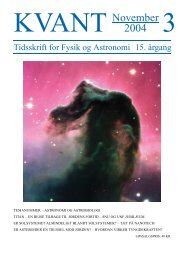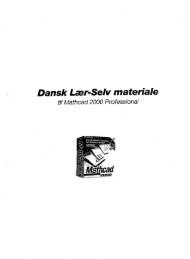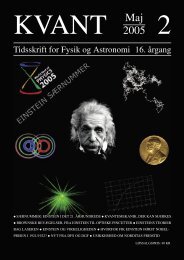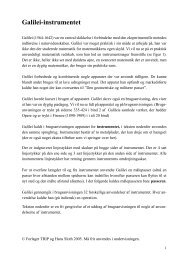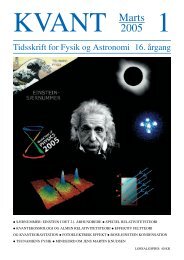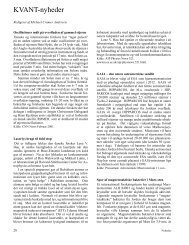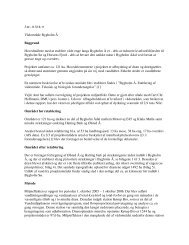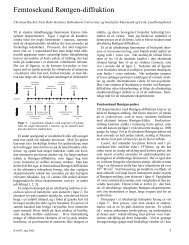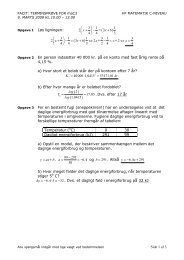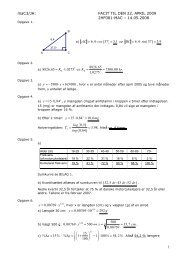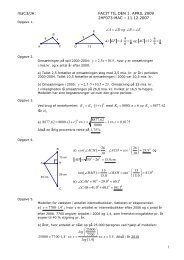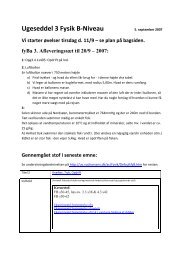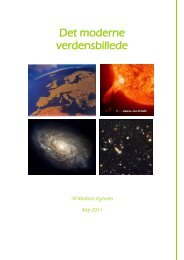Chapter 7 The Outer Planets
Chapter 7 The Outer Planets
Chapter 7 The Outer Planets
Create successful ePaper yourself
Turn your PDF publications into a flip-book with our unique Google optimized e-Paper software.
212 <strong>Chapter</strong> 7 <strong>The</strong> <strong>Outer</strong> <strong>Planets</strong><br />
FIGURE 7-34 Miranda <strong>The</strong> patchwork appearance of<br />
Miranda in this mosaic of Voyager 2 images suggests that<br />
this satellite consists of huge chunks of rock and ice that<br />
came back together after an ancient, shattering impact by an asteroid<br />
or a neighboring Uranian moon. <strong>The</strong> curious banded features that<br />
cover much of Miranda are parallel valleys and ridges that may have<br />
formed as dense, rocky material sank toward the satellite’s core. At<br />
the very bottom of the image—where a “bite” seems to have been<br />
taken out of the satellite—is a range of enormous cliffs that jut<br />
upward as high as 20 km, twice the height of Mount Everest. (NASA)<br />
VIDEO 7.9<br />
the Voyager mission. However, Voyager’s cameras discovered<br />
ten additional satellites, each fewer than 50 km across.<br />
Still others have since been observed from Earth. Several of<br />
these tiny, irregularly shaped moons are shepherd satellites<br />
whose gravitational pull confines the particles within the<br />
thin rings that circle Uranus.<br />
<strong>The</strong> smallest of Uranus’s five main satellites, Miranda, is<br />
the most fascinating and bizarre of its 21 known moons.<br />
Unusual wrinkled and banded features cover Miranda’s surface<br />
(Figure 7-34). Its highly varied terrain suggests that it<br />
was once seriously disturbed. Perhaps a shattering impact<br />
temporarily broke it into several pieces that then recoalesced,<br />
or perhaps severe tidal heating, as we saw on Io, moved large<br />
pieces of its surface.<br />
Miranda’s core originally consisted of dense rock, while<br />
its outer layers were mostly ice. If a powerful impact did<br />
occur, blocks of debris broken off from Miranda drifted back<br />
together through mutual gravitational attraction. Recolliding<br />
with that moon, they formed a chaotic mix of rock and ice.<br />
In this scenario, the landscape we see today on Miranda is<br />
the result of huge, dense rocks trying to settle toward the<br />
satellite’s center, forcing blocks of less dense ice upward<br />
toward the surface.<br />
NEPTUNE<br />
Neptune is physically similar to Uranus (review Figures 7-28<br />
and 7-30). Neptune has 17.1 times the Earth’s mass, 3.88<br />
times Earth’s diameter, and a density of 1640 kg/m 3 . Unlike<br />
Uranus, however, cloud features can readily be discerned on<br />
Neptune. Its whitish, cirruslike clouds consist of methane ice<br />
crystals. <strong>The</strong> methane absorbs red light, leaving the planet’s<br />
belts and zones with a banded, bluish appearance (Figure<br />
7-35). Like Jupiter, the atmosphere of Neptune also experiences<br />
differential rotation. <strong>The</strong> winds on Neptune blow as<br />
fast as 2000 km/h—among the fastest in the solar system.<br />
Zones<br />
(light blue)<br />
South pole<br />
Belts<br />
(dark blue)<br />
High-altitude<br />
clouds<br />
FIGURE 7-35 Neptune’s Banded Structure. Several<br />
Hubble Space Telescope images at different wavelengths<br />
were combined to create this enhanced-color view of<br />
Neptune. <strong>The</strong> dark blue and light blue areas are the belts and zones,<br />
respectively. <strong>The</strong> dark belt running across the middle of the image lies<br />
just south of Neptune’s equator. White areas are high-altitude clouds,<br />
presumably of methane ice. <strong>The</strong> very highest clouds are shown in<br />
yellow-red, as seen at the very top of the image. <strong>The</strong> green belt near<br />
the south pole is a region where the atmosphere absorbs blue light,<br />
perhaps indicating some differences in chemical composition.<br />
(Lawrence Sromovsky, University of Wisconsin-Madison and STScI/NASA)<br />
WEB LINK 7.24




